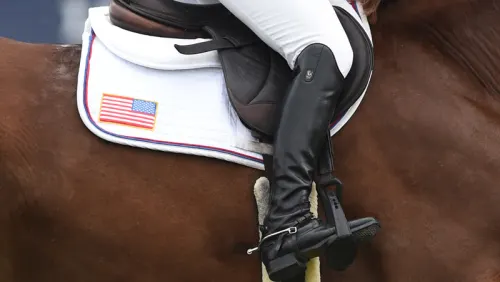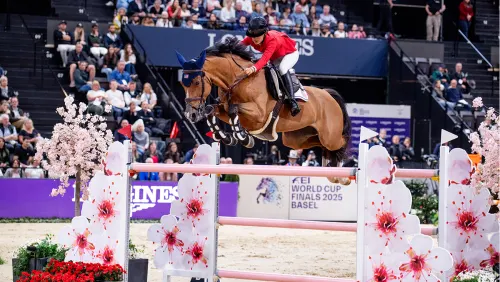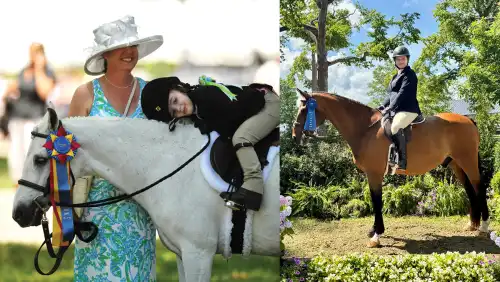Janik Gasiorowski, VMD, DACVS, of Mid-Atlantic Equine Medical Center (New Jersey) explains which race horse conditions are unlikely to interfere with a sport horse career.
The scariest injury most people associate with racing is some type of fracture. For example, the horse has screws in one leg. Is that a red flag?
Dr. Gasiorowski: What you’re looking for is incomplete nondisplaced fractures. Horses that go through incomplete nondisplaced fractures and have repair done, with just a screw or two, that’s usually an excellent prognosis. As long as the joints that broke are free from other pathology, you can often have a really good horse.
In most scenarios, if somebody is looking to adopt a horse, the fracture has probably already been fixed. So what comes to light is, you’re going to be seeing radiographs with screws. That does not need to scare you, but you need to look into the history. You’re going to need to have a surgeon look at the radiographs, and potentially look at the pre-op images, and see what type of fracture it was.
But some of the best and most successful second-career horses have been fracture repairs. That’s a big one; we do a lot of those. We treat those nondisplaced incomplete fractures at this hospital with the horse standing. With one or two screws, the outcome is excellent, especially for a non-racing horse.
Chip fractures are a different subject. Obviously, if you talked to a panel of surgeons, you’re going to get an hour of discussion on each one of these points. Trying to boil it down to simple guidelines people can understand, in general, chip fractures in the upper joint of the knee tend to be quite favorable. Chip fractures in the middle joint of the knee are quite unfavorable. And chip fractures in the fetlock are somewhere in between.
What kind of prognosis do you give for soft tissue injuries?
Dr. Gasiorowski: For me, for horses that you’re hoping will have an athletic career, I’ll draw the line at the suspensory ligament. If it’s a mild injury, fine, but if you’ve got significant branch or body or origin injuries in the suspensory, [that horse is] not going to make it as an athlete.
Some of the bowed tendon type injuries, your classic bowed superficial flexor tendons, given enough time to recover, they’ll do really well in other careers. No horse bows the superficial quite like a race horse does, which is why some of the bows that we see in the superficial are unique to the race horse. We don’t see them that much in other [disciplines]. That’s why, if you give that lesion time to fill in, they’ll do really well.
There are surgeries that can be done, as well, like superior check desmotomy–cutting the superior check ligament at the top of the superficial flexor tendon. It can have a strongly positive effect on the downstream outcome.
ADVERTISEMENT
In the front leg of the horse there are two check ligaments that we talk about. There’s the inferior check that connects the deep flexor tendon to the back of the cannon bone, and the superior check that connects the superficial flexor tendon to the back of the radius [forearm] above the knee. You can picture those ligaments like small leashes that tether the tendinous portion of those structures to the back of the bones for extra support.
Let’s stick with an injury to the superficial flexor tendon, because if the horse has deep flexor problems, that’s a major problem. But if the horse has a superficial flexor bow, it’s because the horse is applying too much strain in the superficial flexor tendon.
If you cut the superior check ligament, what you’re doing is releasing that leash from the back of the radius. Now when the horse loads up that tendon, the strain is transmitted directly into the muscle fibers of the superficial digital flexor muscle.
You’re allowing the entire musculo-tendinous unit of the superficial digital flexor to elongate, to stretch out more than it would be able to [prior to desmotomy]. In doing that, you’ve changed the way that strain runs through the tendon, and that allows some injuries to heal better than they would without that surgery.
As a matter of fact, most race horses getting that procedure will then return to racing. That’s how successful that procedure is.
What advice do you have for maintaining ex-race horses’ feet?
Dr. Gasiorowski: Thoroughbred feet are small, usually thin, thin walls. They have a tendency to grow long toes; they have a tendency for underrun heels, and they’ve spent a career being trimmed for a very fast, light foot, which means minimal sole depth.
That is not always a curse. You need to give the horse time to grow out the foot, work with your farrier. I think the most critical time point is making sure that as the horse comes out of the racing plates, somebody is paying attention that the heels are growing down properly. Left to their own devices, they’ll continue to crush the heel and grow that typical Thoroughbred slippered-forward foot.
If you’ve got someone really paying attention to how the heel is growing down the first time they’re allowed to grow down—like with a yearling, basically—that can make a substantial difference in where it goes in the future.
What about horses with soreness or stiffness through the back or kissing spines?
ADVERTISEMENT
Dr. Gasiorowski: Sore backs, sore necks, there are a lot of complaints to that effect. That’s a complex analysis, but I rarely see a Thoroughbred race horse with strictly back soreness. It’s usually caused by something else. What that something else is could be anything on your whole menu of lamenesses that could affect a Thoroughbred race horse. So while we do see sore-backed horses, that’s usually not the primary problem. If you treat the primary problem, the back soreness often goes away.
When you’re talking about kissing spines, it’s important to determine whether what you see on radiographs is or is not clinically relevant. In our practice, 80% of the abnormal dorsal spinous processes we see on radiographs are non-clinical–they’re turning up on pre-purchase evaluations of horses who appear clinically normal. For the average potential owner, in the absence of clinical signs, I wouldn’t freak out about a radiograph.
Should a potential buyer avoid a horse that ran with Lasix?
Dr. Gasiorowski: No. No worry at all. Lasix [a brand name for furosemide, the anti-bleeding and diuretic medication permitted at most North American tracks] has a rapid and temporary effect on the horse that helps to prevent exercise-induced pulmonary hemorrhage. And it also makes them lighter, if they urinate a significant volume right before the race. There are some medical benefits and some racing benefits to its use.
Lasix has never been associated with any definitive injury or anything like that. Just because the horse has been getting Lasix to race doesn’t mean that you need to be watching out on the far side for something. So just because a horse raced with Lasix doesn’t mean that it is a bleeder or is going to be a bleeder.
A graduate and past staff surgeon at the University of Pennsylvania School of Veterinary Medicine, Dr. Gasiorowski’s clinical interests include orthopedic and upper respiratory surgery, lameness diagnosis and nuclear scintigraphy, as well as the transitioning of Thoroughbred race horses to second careers.
This article appeared in the September 23 & 30 2019, issue of The Chronicle of the Horse as part of our Thoroughbred issue.
You can subscribe and get online access to a digital version and then enjoy a year of The Chronicle of the Horse and our lifestyle publication, Untacked. Or you can purchase a single issue or subscribe on a mobile device through our app The Chronicle of the Horse LLC.
If you’re just following COTH online, you’re missing so much great unique content. Each print issue of the Chronicle is full of in-depth competition news, fascinating features, probing looks at issues within the sports of hunter/jumper, eventing and dressage, and stunning photography.
What are you missing if you don’t subscribe?














